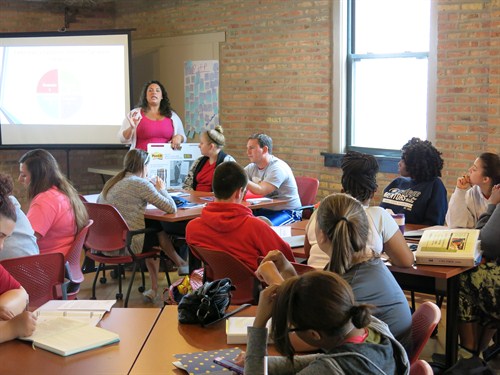Many student teachers are faced with the challenge of co-teaching, which can be a beneficial experience for both teachers and students when planning and communication is established. By learning the different co-teaching strategies and knowing how to apply it in the classroom, student teachers can overcome this challenge and be effective in the classroom.
With the start of student teaching clinicals right around the corner, it’s imperative to begin devising and building positive co-teaching strategies. This year, the Summer Teacher Education Partnership for Urban Preparation (STEP-UP) Fellows began their internship with a professional development (PD) course, Co-Teaching Best Practices, facilitated by Illinois State University Special Education Clinical Assistant Professor Ashley Wolinski. The professional development course aimed to understand the importance of collaboration by describing and learning how to apply the co-teaching models, as well as, providing resources to use for co-teaching and collaboration.
The PD course kicked off with the Fellows sharing their ideas and concerns about co-teaching. Jasmine Grullon, an Albany Park Fellow who was placed at the Patrick Henry minicamp, stated:
“I think my biggest co-teaching concern was wondering if my co-teacher and I would get along and work well together. We didn’t know each other, except the one meeting we had before STEP-UP started.”
Amanda Johnston, who was co-teaching with Grullon, stated:
“My biggest co-teaching concern was that I had never co-taught before. There was a lot of nervousness associated with it being the first time teaching in front of a whole classroom. Sharing that experience with someone else really helped foster a balance between the two of us to work together and rely on each other more.”
This activity led into a meaningful discussion about why general educators and special educators collaborate to plan, assess, and manage the classroom. “Electronic collaboration is a start. In-person discussion and shaping of plans together is essential, which must begin before the first day of school and should be consistent throughout the duration of the school year,” Wolinski said.
She followed the discussion with an explanation of the six co-teaching models: parallel teaching; station teaching; team teaching; alternate teaching; one teach, one assist; and one teach, one observe. The Fellows discussed the strengths and weakness of each model and how to apply each in their summer school placement. Grullon and Johnston had decided that a team teaching approach would be most appropriate for their teaching styles and classroom environment. They had decided to meet daily to plan their lessons. Jasmine said:
“Whoever was most confident and knowledgeable about a specific topic would speak first. If the students did not understand, we would switch roles, building off of each other. It will work out well for us. The students will be able to see that we both have equal ‘power’ in the classroom.”
So what did the co-teaching strategies really look like in their class-room? Johnston said:
“Ideally we wanted to strive for team teaching as it would work best for the both of us. There were days that it was more of a one teach, one assist as one was leading instruction and the other was passing out materials or ensuring that students were staying on task. There were also days where it started being team teaching and then turned into station teaching as we would go and help the students on more of an individual group basis. I think that using varying models of co-teaching is what worked best for the students as it kept each day new and different than that of the previous days as well as helped to keep them engaged in the material presented.”
By learning the co-teaching strategies, both Johnston and Grullon were able to further develop their communication and teaching skills. Grullon declared her experience was rewarding,
“I never really thought about co-teaching until I was told that I would be co-teaching in STEP-UP. As co-teachers, we really have to be on the same page in order to instruct effectively. Also, communication is key! Talking to Amanda, asking her questions really helped with our instruction and how we were going to approach the classroom. Even though I still have a lot to learn about co-teaching strategies, I think that this experience really helped me prepare towards what I might experience as an in-service teacher.”
In the same tone, Johnson stated:
“For it being my first co-teaching experience, I could not have asked for a better co-teacher. I think that since we were both new at co-teaching we were both flexible in regards to what we wanted to accomplish. I think we were also able to have a more open and honest conversation about what did and did not work as we continued to adjust our teaching styles. I would not change anything about our co-teaching experience because it allowed for a lot of growth both individually and collectively. Looking forward to the future, I still have another year before I student teach, but plan on using this experience to further connect to the course work. This experience brought all of the material I had already learned through my course work to life in a way that I was experiencing it as opposed to just reading about it.”

